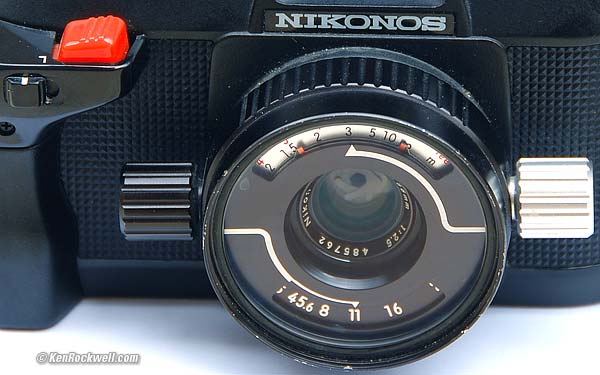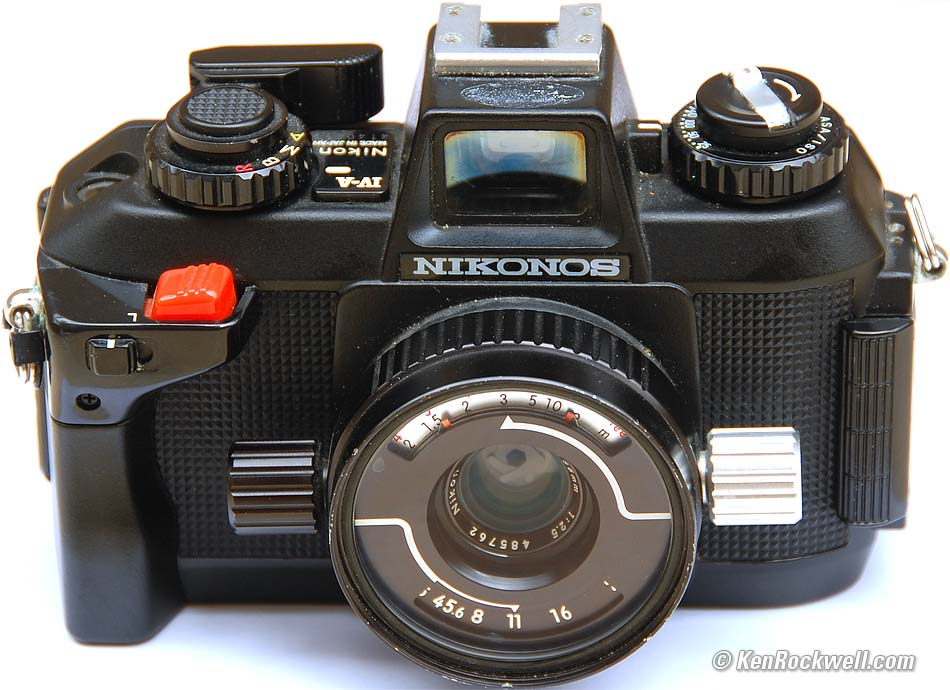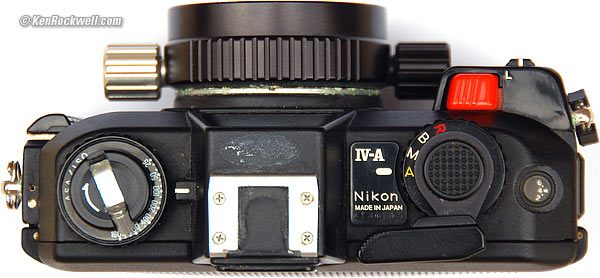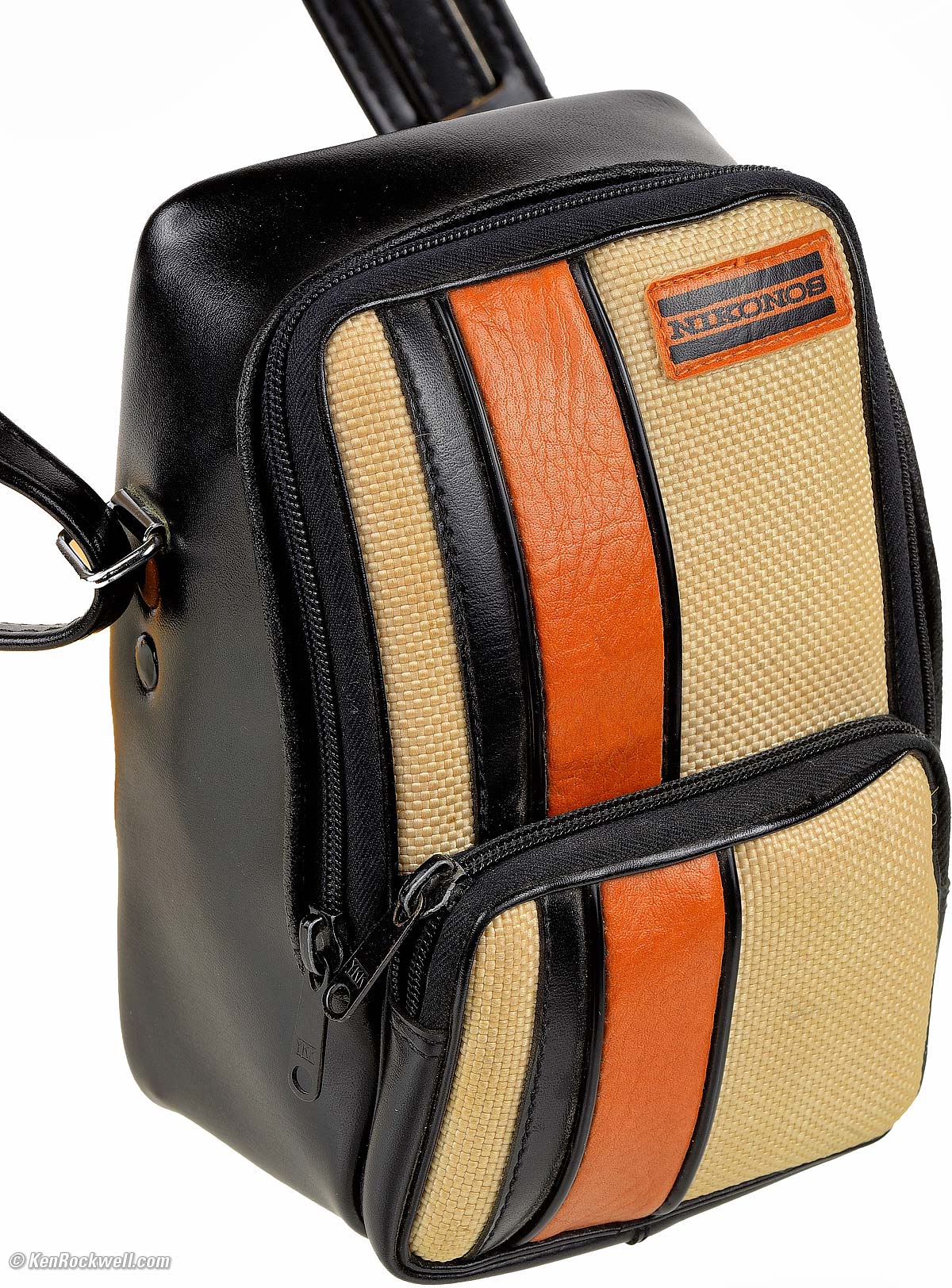Home Donate New Search Gallery Reviews How-To Books Links Workshops About Contact
Nikonos IV-A
35mm Underwater Camera (1980-1983)
Intro Specs Performance Usage Recommendations More
Nikonos IV-A (shoots 35mm film, uses two A76 cells, 58mm filters, 34.1 oz./968g, with film, batteries and strap lugs, 2.75'/0.8m close focus, about $50 used). enlarge. I'd get it at this link directly to them at eBay (see How to Win at eBay).
This all-content, junk-free website's biggest source of support is when you use those or any of these links to approved sources when you get anything, regardless of the country in which you live. Buy only from the approved sources I use myself for the best prices, service, return policies and selection. Thanks for helping me help you! Ken.
Nikonos IV-A.
August 2015 Nikon Reviews Nikon Lenses Underwater Cameras All Reviews
NEW: Underwater Cameras Compared April 2016
NEW: Nikonos V Review April 2016
Introduction top
Intro Specs Performance Usage Recommendations More
This is the classic Nikon underwater camera. It's built like a tank and needs no additional housing for depths to 160 feet (50m).
It has interchangeable lenses. The most popular lens is the 35mm f/2.5 which may be used on land, sea or air; in fact, this is a great camera for use in dirty, dusty and wet environments.
History and Models
Dates |
Light |
Battery |
Manual Shutter speeds |
Manual metering |
Auto Exposure |
Shutter speeds in finder |
TTL Flash |
Focus |
|
Nikonos (Calypso) |
1963 - 1968 |
no |
none |
Yes |
no |
no |
no |
no |
scale |
Nikonos II |
1968 - 1975 |
no |
none |
Yes |
no |
no |
no |
no |
scale |
Nikonos III |
1975 - 1980 |
no |
none |
Yes |
no |
no |
no |
no |
scale |
1980 - 1983 |
YES |
2 x A76 |
M 90 and Bulb, only |
no |
YES |
no |
no |
scale |
|
1984 - 2001 |
YES |
2 x A76 |
1,000, 500, 250, 125, M90, 60, 30 & Bulb |
YES |
YES |
YES |
YES |
scale |
|
Nikonos RS (SLR) |
1992 - 2001 |
YES |
yes |
YES |
SLR |
The Nikonos (Calypso), Nikonos-II and Nikonos-III looked like traditional black rangefinder cameras and had slightly trapezoidal bodies. Their finders didn't pop out above the body as they do on the Nikonos IV-A and Nikonos V.
The -A of the Nikonos IV-A signifies new automatic exposure, and the large finder extends above the top plate of the camera.
The Nikonos V added TTL flash, orange or green outside rubber and shutter speeds indicated in the finder.
Lenses are interchangeable among the Nikonos, Nikonos II, Nikonos III, Nikonos IV-A and Nikonos V.
Nikon's only underwater SLR was the Nikonos RS of 1992 - 2001, which uses different lenses.
Specifications top
Intro Specs Performance Usage Recommendations More
These are as I've measured or guessed.
Lenses
Interchangeable.
The 35mm f/2.5 and 80mm f/4 lenses work in water and air.
The 28mm f/3.5, 20mm f/2.8 and 15mm f/2.8 lenses only work under water.
Standard Lens
35mm f/2.5 works on land, sea and air.
6-bladed manual diaphragm stops down to f/22.
Focus from infinity to 2.75' (0.8m).
Filter thread appears to be 58mm.
Filter Size (Standard 35mm lens):
58mm screw-in.
Focusing
Scale focus only. Guess or measure (tape) the distance and set it on the dial. There is no rangefinder. I'm unsure if the distances correspond to water or air.
Depth-of-Field Scale
Magic moving indicators move along the distance scale as you change the aperture.
Exposure Dial Settings
Aperture-preferred Auto (A), Mechanical 1/90 (M), Bulb (B) and (R) for rewind.
ASA/ISO Range
25 ~ 1,600.
Shutter
1/30 - 1/1,000 on Auto, I think.
When tested it seems to be able to go for many seconds at night, an excellent plus. My Nikon FE of this same vintage could exposure perfectly for many minutes at night.
Flash Sync
Via a three-terminal connector under a screw-tight cover on the bottom plate.
Power
Thumb wind and rewind.
Two S76 button cells for meter and shutter.
Power Switch
I can't see any.
The finder LED goes out by itself.
Viewfinder Indications
One red LED explained under operation.
Weight
34.125 oz. (967.5g), with film, batteries and strap lugs, no strap or case, measured.
Case
Nikonos Case. enlarge.
There was a swank case available. It holds the camera with 35mm lens, as well as the instructions and a few small accessories.
Price
About $50 used in April 2016, with 35/2.5 lens.
About $75 in June 2007, with 35/2.5 lens.
Performance top
Intro Specs Performance Usage Recommendations More
The shutter release is lovely: one smooth, long actuation releases the electronic shutter.
Automatic exposure works great.
Usage top
Intro Specs Performance Usage Recommendations More
Easy: there are only four things to set: film speed, the shutter, focus and aperture.
Film Speed
Film speed is set on the left dial: lift and turn. Film loading is by flipping open the back and the pressure plate. Unlatch the back on the left by turning the O-C knob to O (Open).
Shutter Dial
The four shutter settings are around the wind lever on the right: A, M, B and R. Leave it on A, automatic. M is a mechanical 1/90 setting for when your batteries die or for flash. B is Bulb for long exposures (why?), and R is for rewinding the film.
Rewind
To rewind, select R on the right dial, then lift and turn the rewind crank on the left side. Rewinding is clockwise as marked on the crank. Open the back, remove the film and then rotate the crank backwards (counter-clockwise) to push it back in.

Nikonos IV-A Focus and Diaphragm Controls
Focus
Set the focus distance by twisting the silver knob. Guess or use a tape measure. Depth-of-field is shown by the two red pointer which move as you set the aperture.
If you set the infinity mark to the red dot as shown above, you ought to have everything from the distance at the other red dot (6' or 1.8m in this example) in focus.
This distance scale is calibrated for air. If you use a tape underwater you'll need to correct it.
Aperture
Set the aperture (diaphragm or f/stop) with the black knob.
Exposure
Tap the shutter lightly and a red LED appears in the finder. If the red LED stays lit, exposure is correct and in the range of 1/1,000 to 1/30.
If the red LED blinks, exposure is over or under this range, so adjust the aperture until it becomes steady.
In dim light the exposure ought to be fine even if blinking, but the picture may be blurred from a long exposure. Hold steady or use a tripod.
O-Rings
I have no idea. I don't use this underwater. People who use underwater cameras love to brag about the expensive gear they flood. Get one tiny spec of grit on the O-ring and you're dead.
Lens Changing
Thee is no bayonet lock to release, just a detent.
Twist the lens body 90 degrees until the silver knob is in front of the finder. Pull out the lens.
To replace a lens, put the silver knob in front of the finder and push in. Rotate 90 degrees until it's back as shown above.
I point the camera down so crud falls out, instead of into the focal plane shutter.
Underwater users pay close attention to the O-ring seals and grease. I don't know these procedures.
Recommendations top
Intro Specs Performance Usage Recommendations More
This was a gift from Daniel in Sedona when he discovered that no one wanted this camera. Strange, but true. Today of course it only shoots film, but gosh, this is a sealed, waterproof, crap and crud-proof solid brick of a camera perfect for shooting anything that might shoot back or be messy. Try it in the surf!
Oddly the one I was given has some green corrosion on some of the chrome. What? This is an underwater camera - how on Earth does it corrode? It lives underwater! People tell me it corrodes when people forget to rinse it in fresh water after using it in salt water.
If you've found all the time, effort and expense I put into researching and sharing all this, this free website's biggest source of support is when you use these links, especially this link directly to them at eBay (see How to Win at eBay), when you get anything, regardless of the country in which you live. Thanks! Ken.
More Information top
Intro Specs Performance Usage Recommendations More
© Ken Rockwell. All rights reserved. Tous droits réservés.
Help me help you top
I support my growing family through this website, as crazy as it might seem.
The biggest help is when you use any of these links to approved sources when you get anything, regardless of the country in which you live. It costs you nothing, and is this site's, and thus my family's, biggest source of support. These places have the best prices and service, which is why I've used them since before this website existed. I recommend them all personally.
If you find this page as helpful as a book you might have had to buy or a workshop you may have had to take, feel free to help me continue helping everyone.
If you've gotten your gear through one of my links or helped otherwise, you're family. It's great people like you who allow me to keep adding to this site full-time. Thanks!
If you haven't helped yet, please do, and consider helping me with a gift of $5.00.
As this page is copyrighted and formally registered, it is unlawful to make copies, especially in the form of printouts for personal use. If you wish to make a printout for personal use, you are granted one-time permission only if you PayPal me $5.00 per printout or part thereof. Thank you!
Thanks for reading!
Mr. & Mrs. Ken Rockwell, Ryan and Katie.
Home Donate New Search Gallery Reviews How-To Books Links Workshops About Contact



